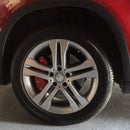Introduction: How to Change Your Air Filter
Changing your air filter is one of the best things you can do for your car. If your air filter has become dirty (and it will!) your engine will start to become sluggish, unresponsive, and inefficient. Your MPG will plummet, and the strain put on your engine could lead to permanent damages. Not only is it imperative for you to change your air filter regularly, it’s also one of the easiest repairs to do yourself at home. Here’s how:
Step 1: Pick Your Replacement Filter
There are a lot of air filters to choose from - and any clean filter will provide better air flow and more power than your dusty and grimy filter. Standard filters should be replaced about once a year (or every 30,000 miles or so), possibly more if you live in a very dusty area. Some of the more performance oriented brands, such as K&N or S&B, can actually be removed, cleaned, and reinserted. What’s more, your performance filters are typically custom-designed to drop right in to your specific vehicle.
Step 2: Set the Stage
First thing's first
Make sure you’re parked on level ground, kill the ignition, and pop open the hood. Yes, you’re rolling your eyes, I know. But this is an important step that’s always worth mentioning.
Find and open your air filter unit
Your unit is probably located on top of the engine. Probably. Check your vehicle’s manual to find out exactly where it is, as it does vary from vehicle to vehicle.
There’s usually a plastic or metal cover on it. Loosen the clamp that seals your filter unit to the air conduit, and remove any screws, clamps, or nuts that hold the lid in place, and remove it. Add something here about consulting with your vehicles manual to properly locate your air filter. You could even add that on some vehicles access may not be from the engine bay.
Clean up time
Grab some tape (something that’s easy to remove – like scotch or masking tape) and cover up your air conduit. You don’t want anything to fall through there while you’re working. With that covered you can take a vacuum or an air compressor and clean your air filter housing to make sure no debris gets left behind. Don’t forget to take the tape off when you’re done.
Step 3: Drop It in Place
Drop your new filter in place (or in the case of some performance filters – drop the cleaned filter back in place). Make sure the rubber rim seals all of the edges. Grab that lid and put it back in place, using whatever clamps or screws you removed to being with. This step is important because if your cover is not properly aligned, you could pay for it in your engine performance.
So now you’re done. Your vehicle is healthier and will perform better, and it took you just a couple of minutes. Honestly, you never need to bother paying a mechanic to do this. (In fact, some unsavory garages might have a filthy air filter on hand that they carry out and tell people it came out of their car. Lucky for you, you know better than to fall for that.)
Step 4: Maintenance
So once again, 12 months or 30,000 miles is your rule of thumb, be sure to write down where your mileage is on the day you change the filter. I like to keep a little notebook in my glove box where I can jot down my vehicle related information. That way I always remember where it is. You might want to change it out more often if you live in a dustier region. And that’s it, you’re good to go.













